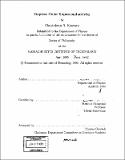Gapless color superconductivity
Author(s)
Kouvaris, Christoforos N
DownloadFull printable version (8.809Mb)
Other Contributors
Massachusetts Institute of Technology. Dept. of Physics.
Advisor
Krishna Rajagopal.
Terms of use
Metadata
Show full item recordAbstract
In this thesis, we propose and investigate the "Gapless Color-Flavor Locked" (gCFL) phase, a possible new phase of dense and cold quark matter. At high enough densities, quarks interact with each other and form pairs similarly to electrons in superconductors. This phenomenon in the case of quark matter is called Color Superconductivity. Color superconducting matter must be electrically and color neutral, because otherwise there are huge energy costs, due to the charges. At asymptotically high densities, equal numbers of up, down, and strange quarks make the system neutral, all the quarks pair, and the quark matter is in the Color-Flavor-Locked phase. At intermediate densities however, the strange quark mass changes the number densities of the quarks and this makes the CFL phase unstable. The gCFL phase emerges as a result of the strange quark mass effect and the neutrality conditions. The gCFL phase has gapless modes and non-zero electron density, unlike CFL. These new properties of gCFL have significant astrophysical implications. The interior of neutron stars might have densities at the regime where gCFL dominates. If this is the case, we argue that gCFL will change significantly the cooling of such a star, keeping it hot, even for late times. Also in this thesis we explore the rest of the phase diagram of neutral quark matter at high density as a function of temperature and strange quark mass. We investigate how zero temperature superconducting phases evolve if we heat the system. We derive the phase diagram of dense quark matter using a Nambu-Jona- Lasinio (NJL) model, that might be a good guide for understanding the QCD phase diagram.
Description
Thesis (Ph. D.)--Massachusetts Institute of Technology, Dept. of Physics, 2005. Includes bibliographical references (p. 155-164).
Date issued
2005Department
Massachusetts Institute of Technology. Department of PhysicsPublisher
Massachusetts Institute of Technology
Keywords
Physics.